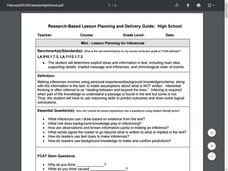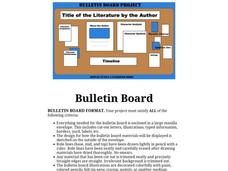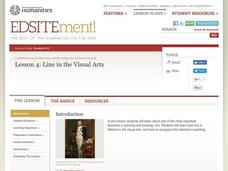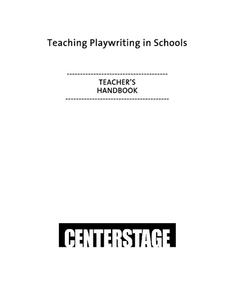EngageNY
Grade 9 ELA Module 1: Unit 3, Lesson 18
Why is Romeo and Juliet considered a tragedy? Class members conclude their reading of the play, focusing on the final lines of Act 5, scene 3. They also consider how Shakespeare structures the text, orders events, and manipulates time to...
Curated OER
Mini-Lesson Planning for Inferences
Making inferences and drawing conclusions is a key component to successful active reading. Encourage your class to use context clues and prior knowledge to infer different elements of a story, including the setting, plot, and character...
Curated OER
Paper Maché Mancala Game Boards
Seventh graders create three dimensional works of art from two dimensional plans, develop skills in papier-mach?? technique, utilize elements and principles of design to create 3-D form, and develop math/strategy skills in playing the...
California Federation of Chaparral Poets, Inc
Poetic Devices
Have everything you need to know about the elements of poetry with a nine-page handout. Split into four categories—word sounds, meanings, arrangement, and imagery—budding poets may reference terms, read definitions, descriptions, and...
Curated OER
Fine Art to Animation With Keith Haring
Fifth graders create their own morphes in the computer lab emphasizing lines and color and explain them. In this art lesson plan, 5th graders base their creations on the work of Keith Haring.
Curated OER
EXPRESSIONIST ART LESSON
Sixth graders design and compose a picture that conveys a specific emotion or feeling, and recognize the use of emotion in a variety of artworks using crayons and/or pastels. They experiment and manipulate elements of art including, line...
Curated OER
Ripped Paper Art - Snowmen, Mountains and Evergreens
Students discover depth in photographs or paintings by creating a picture from scrap paper. In this art analysis lesson, students practice creating depth by placing different elements higher or lower on a picture. Students utilize torn...
Sandra Effinger
Bulletin Board Project
Imagine a project that informs and entertains. Replace book reports with a bulletin board that highlights all the important elements of a novel. Readers research the author, create a timeline of events in the story, write a character...
Curated OER
Tortoise and Hare Races
Practice basic map skills with the story of The Tortoise and the Hare. After listening to the story, class members create a map that indicates the starting line, the path the animals took, where they stopped to rest, and the finish line....
Curated OER
Celebrate Change
Students develop fantasy creatures and characters, describing personalities in terms of gestures, actions, and expressions displayed. Then they make fantasy masks, focusing on shape, form, proportion, line, and emphasis to demonstrate...
Novelinks
The Little Prince: Concept/Vocab Analysis
Focus on the literary elements of Antoine de Saint-Exupéry's The Little Prince with a concept analysis sheet. With suggestions and explanations for many of the book's concepts, vocabulary, and other issues that may arise in instruction,...
Brigham Young University
The Presentation
As their final act in a 10-lesson theater arts unit, set designers present their models to the class and explain how their choices of line, color, and texture support the theme they wish to convey.
Curated OER
Ordering Stories
What happened first? Learners examine four sets of images to sequence events using ordinal numbers. There is an example to get them started, and the first two have three pictures to organize. The final story is more challenging with four...
Brigham Young University
It's All in the Details
Designers communicate their vision for a set through a progression from thumbnail sketches, to drawings, to renderings. After examining a series of renderings, class members begin work on their own rendering paying particular attention...
Curated OER
Communicating Feelings through
Sixth graders use subjects, themes, and symbols to communicate meaning in their own works of art. They describe the origins of specific images and ideas and explain why they are of value in their artwork and in the work of others.
Curated OER
Mysteries of the Past-An Artistic Expedition
Students explore expression in artwork. In this interdisciplinary lesson, students travel to ancient Egypt to examine abstract art of the Nile River valley through several hands-on activities.
Curated OER
Line Elements
Young scholars discover line elements. In this visual arts lesson plan, students fold construction paper into eight boxes and fill each box with various types of lines.
Curated OER
Follow the Leader: Line in the Visual Arts
Students identify line in the composition of a number of art works. They explain how the artist's compositional choices guide the viewer's eye to important components of the image. Students identify sight lines in several paintings and...
Incredible Art
Skateboard Deck Graphics
Young artists don't need to be skateboarders to enjoy this assignment. Class members use the provided worksheet to craft 10 sketches that convey action or motion using no more than seven lines. They then select their three best ideas and...
Learning to Give
Teaching Playwriting in Schools
The world is a stage, and so is your classroom! Hone the skills of the next generation of Tony® award winners with a set of exercises, reference pages, writing prompts, and excerpts from famous plays.
Charanga
Sing!
Whether new to the Kodály Method of music instruction or an experienced veteran, you'll find much to make your heart sing in a teacher guide that was designed for a music appreciation project.
Curated OER
Rhythm and Art: Rhythm Collage
Students create a collage in response to musical rhythm. In this visual arts lesson plan, students will better understand the connection between visual arts and musical rhythm. Students will follow the teacher's model of letting the...
Curated OER
Elements and Principles Using a Movie
Young scholars identify the elements and principles that appear in an illustration of a room and explain each concept in writing. They watch this movie identifying each of the elements and principles of design portrayed in the interiors...
Curated OER
Lots of Lines
Students see that artists make many different kinds of lines. They discuss how artists use line to show ideas such as motion, mood, or emphasis. They geet a "scribble" to transform into a picture using Colorific markers or erasable crayons.

























